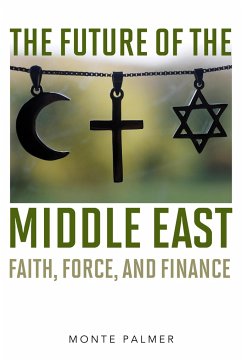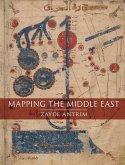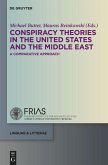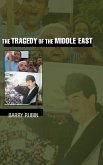Schade – dieser Artikel ist leider ausverkauft. Sobald wir wissen, ob und wann der Artikel wieder verfügbar ist, informieren wir Sie an dieser Stelle.
- Gebundenes Buch
- Merkliste
- Auf die Merkliste
- Bewerten Bewerten
- Teilen
- Produkt teilen
- Produkterinnerung
- Produkterinnerung
This deeply informed book considers the intertwined roles of faith, force, and finance in shaping the modern Middle East. Leading expert Monte Palmer argues that these factors will continue to have a major impact on the Middle East as the United States and other major powers increasingly find themselves embedded in conflicts that defy resolution. Palmer considers the lessons learned from past and current conflicts: the limits of using tyrants as avenues of force; the transformation of faith into force; the root causes of terror; and the perils of a global environment that threatens a new cold…mehr
Andere Kunden interessierten sich auch für
![Mapping the Middle East Mapping the Middle East]() Zayde AntrimMapping the Middle East65,99 €
Zayde AntrimMapping the Middle East65,99 €![Conspiracy Theories in the United States and the Middle East Conspiracy Theories in the United States and the Middle East]() Conspiracy Theories in the United States and the Middle East82,99 €
Conspiracy Theories in the United States and the Middle East82,99 €![A History of the Middle East A History of the Middle East]() Peter MansfieldA History of the Middle East22,99 €
Peter MansfieldA History of the Middle East22,99 €![The Tragedy of the Middle East The Tragedy of the Middle East]() Barry RubinThe Tragedy of the Middle East50,99 €
Barry RubinThe Tragedy of the Middle East50,99 €![Kingmakers Kingmakers]() Karl E. MeyerKingmakers30,99 €
Karl E. MeyerKingmakers30,99 €![The Tragedy of the Middle East The Tragedy of the Middle East]() Barry RubinThe Tragedy of the Middle East30,99 €
Barry RubinThe Tragedy of the Middle East30,99 €![A History of the Middle East A History of the Middle East]() Peter MansfieldA History of the Middle East22,99 €
Peter MansfieldA History of the Middle East22,99 €-
-
-
This deeply informed book considers the intertwined roles of faith, force, and finance in shaping the modern Middle East. Leading expert Monte Palmer argues that these factors will continue to have a major impact on the Middle East as the United States and other major powers increasingly find themselves embedded in conflicts that defy resolution. Palmer considers the lessons learned from past and current conflicts: the limits of using tyrants as avenues of force; the transformation of faith into force; the root causes of terror; and the perils of a global environment that threatens a new cold war between Russia and the United States, a war of religions between the Abrahamic faiths, and a war of terror that is rapidly becoming global. As he clearly shows, the relative dominance of faith, force, or finance is always shifting, depending on time, place, and local conditions. Drawing on cases from ten critical periods, from World War I through the current chaos and stalemate, the author offers constructive paths forward for building a Middle East of peace and stability.
Produktdetails
- Produktdetails
- Verlag: Rowman & Littlefield
- Seitenzahl: 216
- Erscheinungstermin: 24. November 2018
- Englisch
- Abmessung: 238mm x 161mm x 25mm
- Gewicht: 460g
- ISBN-13: 9781538117880
- ISBN-10: 1538117886
- Artikelnr.: 52639829
- Herstellerkennzeichnung
- Libri GmbH
- Europaallee 1
- 36244 Bad Hersfeld
- gpsr@libri.de
- Verlag: Rowman & Littlefield
- Seitenzahl: 216
- Erscheinungstermin: 24. November 2018
- Englisch
- Abmessung: 238mm x 161mm x 25mm
- Gewicht: 460g
- ISBN-13: 9781538117880
- ISBN-10: 1538117886
- Artikelnr.: 52639829
- Herstellerkennzeichnung
- Libri GmbH
- Europaallee 1
- 36244 Bad Hersfeld
- gpsr@libri.de
Monte Palmer is professor emeritus of government at Florida State University, where he directed the Middle East Studies Center. He was also director of the Center for Arab and Middle Eastern Studies at the American University of Beirut from 1998 to 2000. His books include The Arab Psyche and American Frustrations, Politics in the Middle East, and Islamic Extremism: Causes, Diversity, and Challenges.
Preface 1 The Power of Faith, Force, and Finance The Power of Faith The
Power of Force The Power of Finance Arms Purchases as Power Gifts as Soft
Influence and Image Building Finance as the Key to Regional Control Finance
as Alliance Building Finance as a Social Contract Using Finance to Promote
Faith and Force The United States' Soft Power in the Middle East Between
Faith, Force, and Finance 2 World War I Sets the Stage for the Modern
Middle East (1914-1940) Turkey: Force versus Islam Egypt: The Muslim
Brotherhood Pits Popular Islam against Colonialism Israel: Palestine
Becomes a Homeland for the Jews Iraq: British Control of the Iraqi Shia
Lessons Learned Faith Force Finance The Balance of Faith, Force, and
Finance 3 World War II Reshapes the Middle East (1940-1967) Egypt and Arab
Unity: Using Charisma, Nationalism, and Socialism as Faith Alternatives to
Islam Israel Reborn: War, Peace, and Biblical Prophecy Saudi Arabia: Tribal
Force, Islamic Faith, and the Country's Creation Iran: The Danger of Puppet
Rulers Lessons Learned 4 A Surge of Religious Extremism (1967-1980) Egypt:
Arab Nationalism Collapses and Religious Extremism Surges Israel: Force
Gives Way to Extremism Saudi Arabia: Finance to the Fore Syria and Iraq:
Minority Rule Iraq: Same Formula, Different Faith Lessons Learned 5
Religious Violence Unleashed (1975-1990) Egypt: The Rise of Salafi-Jihadist
Terror and the Muslim Brotherhood The Peaceful Salafi and the
Salafi-Jihadists Salafi-Jihadists versus the Muslim Brotherhood: How They
Differ Saudi Arabia: The Expansion of Salafi Doctrine Iran: The First
Islamic State in the Modern Era Using Faith to Build a Nation Transforming
Faith into Military Force Lessons Learned 6 The Era of Peace, Stability,
and Illusion (1990-2000) How the Collapse of the Soviet Union Fueled
Islamic Extremism in the Middle East Control of the Middle Eastern Tyrants
The Passing of the Ayatollah Khomeini and the Transfer of Faith The
Illusion of Peace between the Israelis and the Palestinians The Formation
of International Islamic Terrorist Networks The Turabi Terrorist Network
Lessons Learned 7 The Era of Global Terror and Counter-Terror (2000-2010)
Afghanistan and the Restructuring of Bin-Laden's Al-Qaeda Network The War
on Terror Expands into Iraq Israel and the War on Terror Saudi Arabia and
the War of Terror Lessons Learned 8 The Era of Islamic Rule (2010-2013)
Islam Lite: The Turkish Model Egypt: Why Rule by the Muslim Brotherhood
Failed The Islamic State of Iraq and Syria (ISIS) Is Iran a Greater Threat
than ISIS? Lessons Learned 9 The Old Order Strikes Back (2017) The United
States Forges an Alliance of Peace and Stability to Build a New Middle East
Turkey as a Link between the Past and Present Israel Strikes Back at the
New Islamic Order Egypt: The United States Declares Coups the First Step
toward Democracy Saudi Arabia: Can the Protector of Islam Protect Itself
from Islam? Lessons Learned 10 Solutions to an Era of Stalemate (Post-2017)
The Stairway to Terror Step 1. Festering Frustration Step 2: Despair Breeds
Violent Groups Step 3: Seeking and Risk Taking Step 4: Weeding Out the
Chaff Step 5: Becoming a Warrior for God Step 6: Consolidation and
Globalization The Failure of Prevailing Counter-Terror Harsh Realities and
Lessons Learned Five Vital Problems to Be Addressed Stopping the Terrorists
Preventing the Despair Base of Terror Preventing Religious Extremists from
Exploiting the Despair of the Masses Working with Islam Resolving Conflicts
that Trigger Violence in the Middle East Solutions Stop the Terror without
Accentuating the Causes and Facilitators of Terror Prevent the Despair Base
of Terror Use Moderate Islam as a Solution to Extremism Integrate Muslims
into the World Community Resolve Conflicts Triggering Violence in the
Middle East Ultimate Solutions Works Cited About the Author
Power of Force The Power of Finance Arms Purchases as Power Gifts as Soft
Influence and Image Building Finance as the Key to Regional Control Finance
as Alliance Building Finance as a Social Contract Using Finance to Promote
Faith and Force The United States' Soft Power in the Middle East Between
Faith, Force, and Finance 2 World War I Sets the Stage for the Modern
Middle East (1914-1940) Turkey: Force versus Islam Egypt: The Muslim
Brotherhood Pits Popular Islam against Colonialism Israel: Palestine
Becomes a Homeland for the Jews Iraq: British Control of the Iraqi Shia
Lessons Learned Faith Force Finance The Balance of Faith, Force, and
Finance 3 World War II Reshapes the Middle East (1940-1967) Egypt and Arab
Unity: Using Charisma, Nationalism, and Socialism as Faith Alternatives to
Islam Israel Reborn: War, Peace, and Biblical Prophecy Saudi Arabia: Tribal
Force, Islamic Faith, and the Country's Creation Iran: The Danger of Puppet
Rulers Lessons Learned 4 A Surge of Religious Extremism (1967-1980) Egypt:
Arab Nationalism Collapses and Religious Extremism Surges Israel: Force
Gives Way to Extremism Saudi Arabia: Finance to the Fore Syria and Iraq:
Minority Rule Iraq: Same Formula, Different Faith Lessons Learned 5
Religious Violence Unleashed (1975-1990) Egypt: The Rise of Salafi-Jihadist
Terror and the Muslim Brotherhood The Peaceful Salafi and the
Salafi-Jihadists Salafi-Jihadists versus the Muslim Brotherhood: How They
Differ Saudi Arabia: The Expansion of Salafi Doctrine Iran: The First
Islamic State in the Modern Era Using Faith to Build a Nation Transforming
Faith into Military Force Lessons Learned 6 The Era of Peace, Stability,
and Illusion (1990-2000) How the Collapse of the Soviet Union Fueled
Islamic Extremism in the Middle East Control of the Middle Eastern Tyrants
The Passing of the Ayatollah Khomeini and the Transfer of Faith The
Illusion of Peace between the Israelis and the Palestinians The Formation
of International Islamic Terrorist Networks The Turabi Terrorist Network
Lessons Learned 7 The Era of Global Terror and Counter-Terror (2000-2010)
Afghanistan and the Restructuring of Bin-Laden's Al-Qaeda Network The War
on Terror Expands into Iraq Israel and the War on Terror Saudi Arabia and
the War of Terror Lessons Learned 8 The Era of Islamic Rule (2010-2013)
Islam Lite: The Turkish Model Egypt: Why Rule by the Muslim Brotherhood
Failed The Islamic State of Iraq and Syria (ISIS) Is Iran a Greater Threat
than ISIS? Lessons Learned 9 The Old Order Strikes Back (2017) The United
States Forges an Alliance of Peace and Stability to Build a New Middle East
Turkey as a Link between the Past and Present Israel Strikes Back at the
New Islamic Order Egypt: The United States Declares Coups the First Step
toward Democracy Saudi Arabia: Can the Protector of Islam Protect Itself
from Islam? Lessons Learned 10 Solutions to an Era of Stalemate (Post-2017)
The Stairway to Terror Step 1. Festering Frustration Step 2: Despair Breeds
Violent Groups Step 3: Seeking and Risk Taking Step 4: Weeding Out the
Chaff Step 5: Becoming a Warrior for God Step 6: Consolidation and
Globalization The Failure of Prevailing Counter-Terror Harsh Realities and
Lessons Learned Five Vital Problems to Be Addressed Stopping the Terrorists
Preventing the Despair Base of Terror Preventing Religious Extremists from
Exploiting the Despair of the Masses Working with Islam Resolving Conflicts
that Trigger Violence in the Middle East Solutions Stop the Terror without
Accentuating the Causes and Facilitators of Terror Prevent the Despair Base
of Terror Use Moderate Islam as a Solution to Extremism Integrate Muslims
into the World Community Resolve Conflicts Triggering Violence in the
Middle East Ultimate Solutions Works Cited About the Author
Preface 1 The Power of Faith, Force, and Finance The Power of Faith The
Power of Force The Power of Finance Arms Purchases as Power Gifts as Soft
Influence and Image Building Finance as the Key to Regional Control Finance
as Alliance Building Finance as a Social Contract Using Finance to Promote
Faith and Force The United States' Soft Power in the Middle East Between
Faith, Force, and Finance 2 World War I Sets the Stage for the Modern
Middle East (1914-1940) Turkey: Force versus Islam Egypt: The Muslim
Brotherhood Pits Popular Islam against Colonialism Israel: Palestine
Becomes a Homeland for the Jews Iraq: British Control of the Iraqi Shia
Lessons Learned Faith Force Finance The Balance of Faith, Force, and
Finance 3 World War II Reshapes the Middle East (1940-1967) Egypt and Arab
Unity: Using Charisma, Nationalism, and Socialism as Faith Alternatives to
Islam Israel Reborn: War, Peace, and Biblical Prophecy Saudi Arabia: Tribal
Force, Islamic Faith, and the Country's Creation Iran: The Danger of Puppet
Rulers Lessons Learned 4 A Surge of Religious Extremism (1967-1980) Egypt:
Arab Nationalism Collapses and Religious Extremism Surges Israel: Force
Gives Way to Extremism Saudi Arabia: Finance to the Fore Syria and Iraq:
Minority Rule Iraq: Same Formula, Different Faith Lessons Learned 5
Religious Violence Unleashed (1975-1990) Egypt: The Rise of Salafi-Jihadist
Terror and the Muslim Brotherhood The Peaceful Salafi and the
Salafi-Jihadists Salafi-Jihadists versus the Muslim Brotherhood: How They
Differ Saudi Arabia: The Expansion of Salafi Doctrine Iran: The First
Islamic State in the Modern Era Using Faith to Build a Nation Transforming
Faith into Military Force Lessons Learned 6 The Era of Peace, Stability,
and Illusion (1990-2000) How the Collapse of the Soviet Union Fueled
Islamic Extremism in the Middle East Control of the Middle Eastern Tyrants
The Passing of the Ayatollah Khomeini and the Transfer of Faith The
Illusion of Peace between the Israelis and the Palestinians The Formation
of International Islamic Terrorist Networks The Turabi Terrorist Network
Lessons Learned 7 The Era of Global Terror and Counter-Terror (2000-2010)
Afghanistan and the Restructuring of Bin-Laden's Al-Qaeda Network The War
on Terror Expands into Iraq Israel and the War on Terror Saudi Arabia and
the War of Terror Lessons Learned 8 The Era of Islamic Rule (2010-2013)
Islam Lite: The Turkish Model Egypt: Why Rule by the Muslim Brotherhood
Failed The Islamic State of Iraq and Syria (ISIS) Is Iran a Greater Threat
than ISIS? Lessons Learned 9 The Old Order Strikes Back (2017) The United
States Forges an Alliance of Peace and Stability to Build a New Middle East
Turkey as a Link between the Past and Present Israel Strikes Back at the
New Islamic Order Egypt: The United States Declares Coups the First Step
toward Democracy Saudi Arabia: Can the Protector of Islam Protect Itself
from Islam? Lessons Learned 10 Solutions to an Era of Stalemate (Post-2017)
The Stairway to Terror Step 1. Festering Frustration Step 2: Despair Breeds
Violent Groups Step 3: Seeking and Risk Taking Step 4: Weeding Out the
Chaff Step 5: Becoming a Warrior for God Step 6: Consolidation and
Globalization The Failure of Prevailing Counter-Terror Harsh Realities and
Lessons Learned Five Vital Problems to Be Addressed Stopping the Terrorists
Preventing the Despair Base of Terror Preventing Religious Extremists from
Exploiting the Despair of the Masses Working with Islam Resolving Conflicts
that Trigger Violence in the Middle East Solutions Stop the Terror without
Accentuating the Causes and Facilitators of Terror Prevent the Despair Base
of Terror Use Moderate Islam as a Solution to Extremism Integrate Muslims
into the World Community Resolve Conflicts Triggering Violence in the
Middle East Ultimate Solutions Works Cited About the Author
Power of Force The Power of Finance Arms Purchases as Power Gifts as Soft
Influence and Image Building Finance as the Key to Regional Control Finance
as Alliance Building Finance as a Social Contract Using Finance to Promote
Faith and Force The United States' Soft Power in the Middle East Between
Faith, Force, and Finance 2 World War I Sets the Stage for the Modern
Middle East (1914-1940) Turkey: Force versus Islam Egypt: The Muslim
Brotherhood Pits Popular Islam against Colonialism Israel: Palestine
Becomes a Homeland for the Jews Iraq: British Control of the Iraqi Shia
Lessons Learned Faith Force Finance The Balance of Faith, Force, and
Finance 3 World War II Reshapes the Middle East (1940-1967) Egypt and Arab
Unity: Using Charisma, Nationalism, and Socialism as Faith Alternatives to
Islam Israel Reborn: War, Peace, and Biblical Prophecy Saudi Arabia: Tribal
Force, Islamic Faith, and the Country's Creation Iran: The Danger of Puppet
Rulers Lessons Learned 4 A Surge of Religious Extremism (1967-1980) Egypt:
Arab Nationalism Collapses and Religious Extremism Surges Israel: Force
Gives Way to Extremism Saudi Arabia: Finance to the Fore Syria and Iraq:
Minority Rule Iraq: Same Formula, Different Faith Lessons Learned 5
Religious Violence Unleashed (1975-1990) Egypt: The Rise of Salafi-Jihadist
Terror and the Muslim Brotherhood The Peaceful Salafi and the
Salafi-Jihadists Salafi-Jihadists versus the Muslim Brotherhood: How They
Differ Saudi Arabia: The Expansion of Salafi Doctrine Iran: The First
Islamic State in the Modern Era Using Faith to Build a Nation Transforming
Faith into Military Force Lessons Learned 6 The Era of Peace, Stability,
and Illusion (1990-2000) How the Collapse of the Soviet Union Fueled
Islamic Extremism in the Middle East Control of the Middle Eastern Tyrants
The Passing of the Ayatollah Khomeini and the Transfer of Faith The
Illusion of Peace between the Israelis and the Palestinians The Formation
of International Islamic Terrorist Networks The Turabi Terrorist Network
Lessons Learned 7 The Era of Global Terror and Counter-Terror (2000-2010)
Afghanistan and the Restructuring of Bin-Laden's Al-Qaeda Network The War
on Terror Expands into Iraq Israel and the War on Terror Saudi Arabia and
the War of Terror Lessons Learned 8 The Era of Islamic Rule (2010-2013)
Islam Lite: The Turkish Model Egypt: Why Rule by the Muslim Brotherhood
Failed The Islamic State of Iraq and Syria (ISIS) Is Iran a Greater Threat
than ISIS? Lessons Learned 9 The Old Order Strikes Back (2017) The United
States Forges an Alliance of Peace and Stability to Build a New Middle East
Turkey as a Link between the Past and Present Israel Strikes Back at the
New Islamic Order Egypt: The United States Declares Coups the First Step
toward Democracy Saudi Arabia: Can the Protector of Islam Protect Itself
from Islam? Lessons Learned 10 Solutions to an Era of Stalemate (Post-2017)
The Stairway to Terror Step 1. Festering Frustration Step 2: Despair Breeds
Violent Groups Step 3: Seeking and Risk Taking Step 4: Weeding Out the
Chaff Step 5: Becoming a Warrior for God Step 6: Consolidation and
Globalization The Failure of Prevailing Counter-Terror Harsh Realities and
Lessons Learned Five Vital Problems to Be Addressed Stopping the Terrorists
Preventing the Despair Base of Terror Preventing Religious Extremists from
Exploiting the Despair of the Masses Working with Islam Resolving Conflicts
that Trigger Violence in the Middle East Solutions Stop the Terror without
Accentuating the Causes and Facilitators of Terror Prevent the Despair Base
of Terror Use Moderate Islam as a Solution to Extremism Integrate Muslims
into the World Community Resolve Conflicts Triggering Violence in the
Middle East Ultimate Solutions Works Cited About the Author








